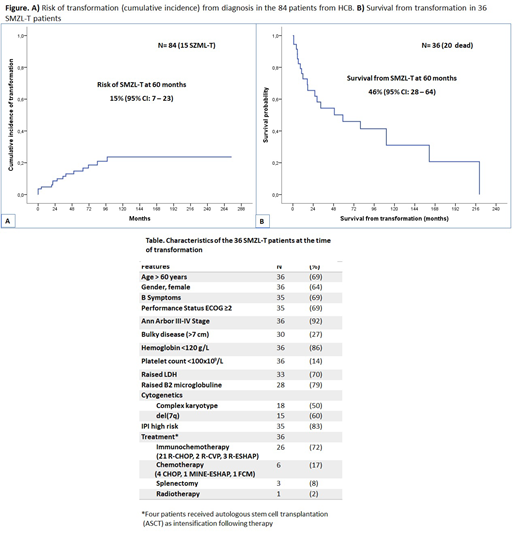BACKGROUND: The clinical course of splenic marginal zone lymphoma (SMZL) is usually indolent, but development of transformation to aggressive lymphoma (SMZL-T) is seen in 10 to 15% of the cases. Risk factors to predict SMZL-T are poorly defined.
AIM: The aims of our study were: 1.- to assess the risk of transformation in a large series of SMZL patients; 2.- to analyze the prognostic factors for this event and 3.- to analyze clinical and biological features of SMZL-T.
PATIENT AND METHODS: We identified 84 SMZL diagnosed at the HCB between 1994 and 2017 and 15 of them (18%) had developed histological transformation (SMZL-T). In addition, we reviewed 21 SMZL with transformation referred to HCB from other centers.
Median age at diagnosis of low-grade SMZL in the 84 patients was 63 years (range, 32-91), and male/female ratio was 34/50. Complex karyotype (CK) defined as ≥3 chromosomal aberrations by conventional cytogenetics was observed in 22% and del(7q) in 59% of cases. The risk distribution according to the Splenic Marginal Zone Lymphoma Study Group simplified score HPLL/ABC was: low: 34, intermediate: 51 and high: 15. After a median follow-up of 80 months (range, 1-265), 37 of 84 (44%) patients have died, with a median overall survival (OS) of 146 months. To assess the risk of transformation and to identify predictive factors for such event, we exclusively evaluated the cohort of 84 patients from HCB.
RESULTS: Fifteen of the 84 patients in the HCB cohort (18%) developed histological transformation. The cumulative incidence of transformation at 60 months from diagnosis was 15% (95% CI: 7 - 23) (Figure). In univariate analysis, variables predicting transformation were anemia, lymphopenia, thrombocytopenia, hypoalbuminemia, CK and high-risk scores of Intergruppo Italiano Linfomi (IIL) and HPLL (p<0.05 for all variables). In addition, lack of response to front-line treatment, relapse, and an early relapse at 12 and 24 months from treatment (p<0.05 for all variables) predicted for a higher risk of transformation. In multivariate analysis, only CK maintained significance to predict transformation (HR 4.85 (CI 95%: 1.15-20.56) p=0.03).
Main clinico-biological features of all 36 SMZL-T patients (including HCB patients and those referred from other centers) are described in the Table. Thirty-five patients transformed to diffuse large B-cell lymphoma (DLCBL) and 1 to Hodgkin lymphoma. Treatment at transformation is detailed in Table. Response was assessable in 34 cases: 21 (62%) achieved a complete response (CR), and 13 patients did not respond. Among responders, 11 continue in CR, 9 relapsed during the follow-up and 1 patient died from therapy related acute myeloid leukemia (AML) when still in CR. Twenty SMZL-T patients (56%) eventually died, 19 related to lymphoma and 1 from AML.
The median survival of the 36 SMZL-T patients from the time of transformation (SFT) was 59 months; with 60-months SFT of 46% (95% CI: 28-64) (Figure). Variables at the time of transformation predicting survival were age >60 years, thrombocytopenia and renal impairment. In addition, patients not achieving a CR, those not receiving an ASCT, and those who relapsed had a poorer SFT (p<0.05 for all variables). In multivariate analysis the independent variables predicting a worse SFT were: age > 60 years (HR 6.28 (95% CI: 1.55-25.39), p=0.01), thrombocytopenia (HR 32.77 (95% CI: 1.97-546.06), p=0.01), and response < CR (HR 8.75 (95% CI: 2.76-27.72), p<0.0001).
Finally, SMZL-T was analyzed as a time-dependent variable for OS, showing that patients who eventually developed transformation had a significant higher risk of death (HR 3.894 (95% IC: 1.816-8.350), p<0.001).
CONCLUSION: The risk of SMZL-T in our series of HCB was 15% at 60 months. The only factor that significatively predicted risk of SMZL-T in a multivariant analysis was the presence of complex karyotype. SMZL-T patients had a significative shorter survival compared to not transformed patients.
Gine:Roche: Other: Travel expenses, Research Funding; Gilead: Other: Travel expenses, Research Funding; Janssen: Other: Travel expenses, Research Funding. Lopez-Guillermo:Celgene: Consultancy, Research Funding; Gilead: Consultancy, Research Funding; Roche: Consultancy, Research Funding; Janssen: Research Funding.
Author notes
Asterisk with author names denotes non-ASH members.


This feature is available to Subscribers Only
Sign In or Create an Account Close Modal